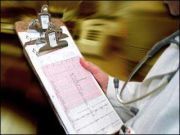Study Shows Benefits of Adopting Novel Insulin Dose Adjustment Algorithm
A novel algorithm for patient self-adjustment of prandial insulin dose could make it easier for patients who are poorly-controlled on basal insulin to add meal-time insulin.

A novel algorithm for patient self-adjustment of prandial insulin dose could make it easier for patients who are poorly-controlled by basal insulin to add meal-time insulin, according to a poster presented at the American Diabetes Association 73rd Scientific Sessions in Chicago, IL.
The algorithm uses a method by which the daily dose of prandial or meal-time insulin is adjusted by the patient at home once per day, as opposed to the method of adjusting the dose every three days which is recommended by current ADA and EASD guidelines, according to Leonard Glass, MD, senior medical director with Eli Lilly and Co. in Indianapolis, IN.
The study described two identical experiments in which patients were randomized either to a regimen of daily prandial insulin self-adjustment, or one in which they adjusted their own level of prandial insulin every three days. In the first study, the daily adjustment regimen was associated with significantly less weight gain than the three-day regimen; in the second study, the daily adjustment was associated with a statistically significant decrease in fasting blood glucose, according to the abstract for poster 46-LB, “The AUTONOMY Study. Initiating and Adjusting Lispro Therapy in Patients with Type 2 Diabetes Mellitus Not Adequately Controlled on Basal Insulin Therapy and Oral Agents.”
“Type 2 diabetes patients are on basal insulin for a long time, but they don’t necessarily progress to prandial or meal-time insulin when they need to, because patients and physicians are reluctant, and most patients with diabetes see a primary care practitioner, because there are not enough endocrinologists,” explained Glass, who presented the poster.
In the clinic, added Glass, doses of prandial insulin are adjusted every three days, when the patient calls the doctor. “We wondered whether this could be done in a more simple way. Patients with type 1 diabetes usually adjust the dose themselves, because they’re better educated, and start it when they’re younger, especially because prandial insulin is their only therapy,” he said.
In the AUTONOMY trial, researchers conducted two identical studies in which type 2 diabetics, between the ages of 18 and 85, were randomized either to the daily dose self-adjustment method, or the every-three-day dose self-adjustment method. The patients had already received insulin glargine, neutral protamine lispro (NPL) insulin, or neutral protamine hagedorn (NPH) insulin, all forms of basal insulin. (Neutral protamine lispro is not available in the US, noted Glass).
Basal insulin was optimized, and then 1,106 patients were randomized and followed for 24 weeks, with the treatment goal of reducing their HbA1c level to 7% or lower. Patients were prescribed prandial insulin, and adjusted their own dose either every day or every three days. Both algorithms added insulin lispro by 1, 2, or 3 injections, as needed, the abstract said.
“We started with one injection per day at meal-time, and then the patient adjusted the dose either up or down by one unit,” Glass explained.
In the first study, patients on the daily adjustment regimen gained less weight (2.15 kilograms compared to 2.96 kilograms) compared to those who adjusted their regimen every three days, (p = 0.014). However, the same measure in the second study was nearly reversed, but lacked statistical significance.
In the second study, 67.86% of those in the daily self-adjustment regimen achieved the target HbA1c level, compared to only 46.1% of those who adjusted their prandial insulin only once every three days (p = 0.015).
In addition, in the second study, patients in the daily-adjustment arm saw a statistically significant decrease in fasting blood glucose, by 6.47 milligrams per deciliter, compared to an increase by 8.03 milligrams per deciliter (p =0.002).
There was no statistically significant difference in hypoglycemia between the two arms in either experiment.